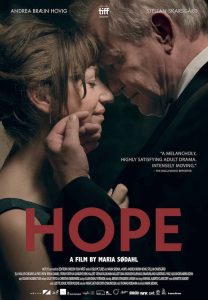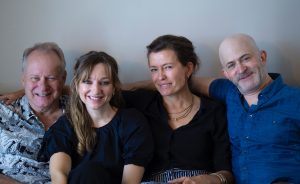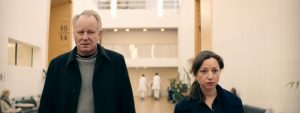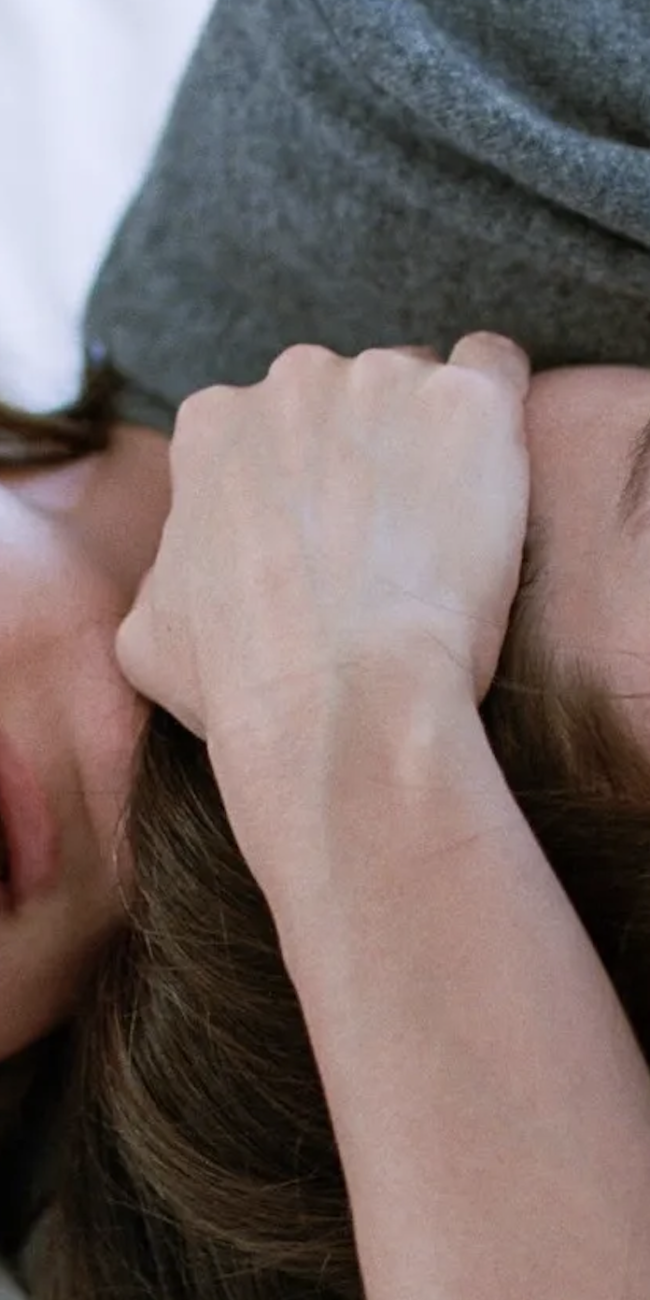A Conversation with Maria Sødahl, Andrea Bræin Hovig and Stellan Skarsgård (HOPE)

I met with Norwegian director Maria Sødahl on Sunday, September 8, 2019, at the 2019 Toronto International Film Festival, to discuss Hope (which I also reviewed), her first feature since the 2010 Limbo. Joining us for the conversation were her two lead actors, Andrea Bræin Hovig (An Affair) and Stellan Skarsgård (Our Kind of Traitor). The film tells the loosely autobiographical story of the director, herself, following Hovig’s Anja as she discovers that she has a malignant brain tumor and only months to live. Her partner, Tomas (Skarsgård) must step up to the plate, rising above the complacency and ennui that long ago infected their once-vibrant relationship. Beyond their own personal issues are the concerns of their three children together and the three children from Tomas’ first marriage. It’s a beautiful movie, neither overly sentimental nor overly bleak. Even with a life on the line, there should always be time for love. Here is a condensed digest of our conversation, edited for length and clarity.
 Hammer to Nail: Maria, please explain the origins of the story. How did you put it together?
Hammer to Nail: Maria, please explain the origins of the story. How did you put it together?
Maria Sødahl: Best recipe for that is to have cancer. So, this is my own story. And that’s the recipe. And to wait six years after the incident before you start telling it so that you have distance and you can see the absurdities. You’ve finished with the crying, you’ve finished with the grief, which makes you not able to do anything. So, that’s where it started at, and I was reluctant to work with the material. Not because I didn’t want to go there, myself, but I didn’t want other people to have to be there.
Firstly, I was just writing and finding memories and studying it, before I knew that this could be something which was fiction and which was worthwhile for other people to look at and deciding how close it should be to reality, which took quite a long time to discover. But at the moment, I had discovered that I had to be 100% truthful to the time-lapse of it, to the medical plot, and to the size of the family with this three plus three, which is reality. When I knew that it had to be like that, then it took a very short time to make the treatment and to just write. But before that, it took a long time.
HtN: Well, congratulations on taking something so personal and making it a film that is so universal. It is really quite beautiful. So, once you had your script, how did you assemble your cast, in particular your two leads?
MS: (pointing to Stellan Skarsgård) Ironically, I found this guy first, who is not the main character. So, I went the wrong way about it, then I cast a lot of female actresses in Norway, between the ages of 35 and 50, actually. I did not know her exact age and I did not know the exact energy she was going to have, and I wanted to be surprised and I wanted to find talent which I hadn’t tried before, etc. Somebody who could be 360 degrees emotionally, who was funny, who was intelligent, and who had depth and could be in every frame and surprise me. All this, and then she came along. And then I put them in the same room afterwards; I did not test them together.
Stellan Skarsgård: It is a pretty odd couple. (laughs)
HtN: Just one other question about the cast: you had to assemble far more than that because you have this marvelous family that you work with. Did it take you a long time to find all the children?
MS: Yeah, that was a priority for this movie. It all had to do with the characters, and we worked with a lot of amateurs. All the doctors in the film are amateurs. They’re doctors, healthcare professionals. Which was really, really fun and interesting to get the personalities behind the white coats. Really funny.
HtN: And the brusqueness with which some of them deliver bad news!
MS: Yes, because actors cannot deal with that. They have to have empathy. And I said okay, but earlier today you have had a really shitty day with your wife so that’s what you come with and then you are going to deliver this. And how do you deliver death sentences? Which is really interesting, because they do not really learn that. And it has nothing to do with what you’re educated for; it is about personality and how experienced you are.

Stellan Skarsgård, Andrea Bræin Maria Sødahl, Hovig and our Chris Reed
HtN: My father is a surgical oncologist, so this is what his life has been like, indeed. So, how did Maria pitch the film to you, Stellan, since you were the first one that she found?
SS: Well, I have known her for 25 years. I have done five films with her husband [Hans Petter Moland] as a director and our families know each other, so I was familiar with the story. But then she sent me a fantastic, beautiful treatment, I think it was 2-3 pages or something, that was just a synopsis and I got very enthusiastic, immediately. Because what it said was that she is not indulging in her own story, she has enough distance to see the comic side of it, the tragic side of it, the helplessness of the characters. It was actually really human and funny and interesting, just in two pages. So that is how I got into it.
HtN: And you, Andrea?
Andrea Bræin Hovig: Well, I read the whole script and immediately fell in love with it. I was not 100 percent sure that it was me who was going to do it, but I knew that it would be a lovely film; I really, really loved the script. But then I got to know Maria and we started to work together, and then I was like, it’s me, it’s me, we’re going to do this! I was thinking about one thing, having the distance from the material, for Maria’s sake, and I experienced also that she has no anger left towards the doctors or being treated badly at the hospital. The humor is left, and the anger is gone, which is very good for me as an actor. It is easier to work with, so then I can be angry because she is not.
(everyone laughs)
HtN: You can be her avatar.
(everyone laughs)
HtN: So, Maria, how much rehearsal time was there, not just between Stellan and Andrea, but also between the children, because I believe, as a viewer, the rapport and I believe them as a family, the children, especially. It all works together. So, how did you assemble them and have them work as a family so it would come across on camera?
MS: I have a lovely casting director who did a great job finding them in the first place. We spent a weekend together with Andrea getting to know each other, and had very interesting discussions about what family life is. They came from very different backgrounds; some backgrounds were very, very sad, quite traumatically sad, and some have never had any problems ever, with anything. So, they came to know each other’s backgrounds very quickly and then I just had to look at them and see the characters, because it didn’t fit into the script, necessarily. And then you have to readjust, and then we had not so many meetings, actually, because I am not into rehearsing scenes.
With the children it is very different, how much you should talk about things. So, I thought it was a lot about being playful together and finding out who they were and then finding out who I was. My casting director took care of some of them and helped them. Only one of them was actually an actor. The young girl, the daughter, she had done one movie, a hit, so she was the most pro. And she is really, really talented; so she was also a guide, without anybody needing to ask.
HtN: Your film has a very intimate shooting style, making of the camera another character. How did you all work together with the cinematographer to make these scenes flow like that? Stellan, you have worked with Lars von Trier, so you are used to the camera being very close to you.
SS: And I have worked with the cinematographer, Manuel [Alberto Claro] with Lars von Trier, as well.
HtN: So there you go; you are old friends. But can you talk about that process of having the camera so close in these raw intimate moments?
SS: I love it! To me, the camera is another actor. I had camera fright for a couple of years; I could not film because then the camera was an enemy. But now the camera is a friend and it is another actor. You act with the camera and I personally feel the presence of the camera and I enjoy it as another actor, but Andrea has a different relationship to the camera which I envy, in a way.
ABH: (laughs) There’s nothing to envy…
SS: Because she can just go “F*** the camera” and go “Wah!” somewhere, which I have problems with. It is very intimate, but I feel it is cozy when the camera is creeping up on us. I mean, it is (to Andrea) you and me and Manuel here, we’re having a good time together.
ABH: And when the camera is on me, and Stellan is next to Manuel, I think you enjoy yourself standing there. It fades like this into the camera; the camera is like your best friend, or your little brother or something.
SS: The camera and I love you. (laughs)
ABH: (laughs) It is so nice to watch.
MS: It is also funny, because Manuel is not like a tall and macho DP [Director of Photography]; he is more like small, feisty … tch-tch-tch … so he is very playful. And he doesn’t make a lot of noise.

A still from “Hope”
HtN: And nor do cameras these days, because when you are shooting digitally, they’re so much less intrusive than before.
MS: Of course, and also my first movie, Limbo, which Manuel also shot, we shot on film. We have the same style, so technique changes, you can shoot more, the costs are not that great. Before, the style was similar, but we never started shooting on the first take or rehearsal. Now, we don’t rehearse, we start shooting at once so that he can get the rhythm. So that’s part of it, that you don’t rehearse, you rehearse with the camera on.
HtN: You shoot the rehearsal, which used to be cost-prohibitive, but not so much anymore.
SS: Manuel is the kind of cameraman that is a part of the scene. He picks up the rhythm of the actors, he follows, he’s doing the scene, he’s not trying to make an elegant framing; there’s nothing coquettish or self-indulgent. He’s really in the scene with the camera, which makes it possible to work with him that way. He’s not an obstruction to the scene.
HtN: And he’s not obtrusive. In other words, the camerawork does not draw attention to itself, at least in this film. It really works to create that sense of intimacy.
MS: Yes.
HtN: Stellan, I have a final question for you since this film was shot in Norway and you’re Swedish. I’m just curious, how many languages do you speak well enough to act in?
SS: I have only acted in English and Swedish, actually. All the Norwegian films I’ve been doing with Maria’s husband and with Maria, now, I have been talking in Swedish. But I’ve done so many Norwegian films in Swedish, I think the Norwegian audience think I’m talking in Norwegian, but I just have sort of a speech impediment. (laughs)
MS: But it’s strange, because he doesn’t even try to talk Norwegian, you know? (laughs) So, actually I thought about that, having a character who’s been living in Norway for, like, 20 years, and he has no Norwegian words or anything. (laughs) But then there is a birthday song, which is not translated in the movie, which starts in Norwegian and then it changes over to the Swedish national birthday song. So that’s the Swedish/Norwegian sort of background story for this family.
HtN: Fascinating. So, you’re just speaking Swedish to everyone?
MS: It comes across like a dialect.
HtN: It’s like a dialect, so they are close enough as languages. Interesting. So, I want to thank you all so much for talking to me. I really enjoyed the film.
All: Thank you!
– Christopher Llewellyn Reed (@ChrisReedFilm)
Like what you see here on Hammer to Nail? Why not pay just $1.00 per month via Patreon to help keep us going?












Pingback: Review of HOPE • HEDMARK?